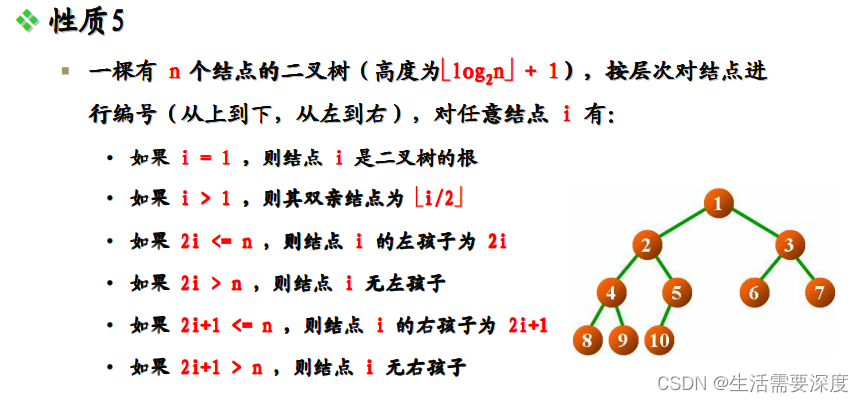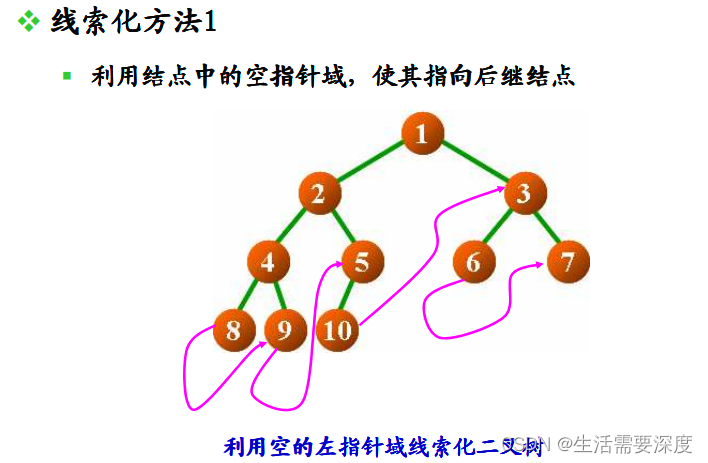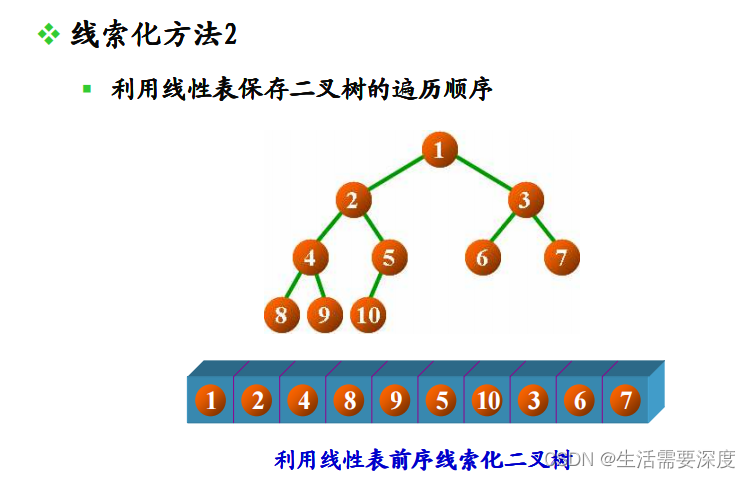1. 二叉树的定义
二叉树是每个节点最多有两个子树的树结构。它有五种基本形态:二叉树可以是空集;根可以有空的左子树或右子树;或者左、右子树皆为空。

2. 二叉树的性质
二叉树有以下几个性质:TODO(上标和下标)
性质1:二叉树第i层上的结点数目最多为 2{i-1} (i≥1)。
性质2:深度为k的二叉树至多有2{k}-1个结点(k≥1)。
性质3:包含n个结点的二叉树的高度至少为log2 (n+1)。
性质4:在任意一棵二叉树中,若终端结点的个数为n0,度为2的结点数为n2,则n0=n2+1。
2.1 性质1:二叉树第i层上的结点数目最多为 2{i-1} (i≥1)
证明:下面用"数学归纳法"进行证明。
(01) 当i=1时,第i层的节点数目为2{i-1}=2{0}=1。因为第1层上只有一个根结点,所以命题成立。
(02) 假设当i>1,第i层的节点数目为2{i-1}。这个是根据(01)推断出来的!
下面根据这个假设,推断出"第(i+1)层的节点数目为2{i}"即可。
由于二叉树的每个结点至多有两个孩子,故"第(i+1)层上的结点数目" 最多是 "第i层的结点数目的2倍"。即,第(i+1)层上的结点数目最大值=2×2{i-1}=2{i}。
故假设成立,原命题得证!
2.2 性质2:深度为k的二叉树至多有2{k}-1个结点(k≥1)
证明:在具有相同深度的二叉树中,当每一层都含有最大结点数时,其树中结点数最多。利用"性质1"可知,深度为k的二叉树的结点数至多为:
20+21+…+2k-1=2k-1
故原命题得证!
2.3 性质3:包含n个结点的二叉树的高度至少为log2 (n+1)
证明:根据"性质2"可知,高度为h的二叉树最多有2{h}–1个结点。反之,对于包含n个节点的二叉树的高度至少为log2(n+1)。
2.4 性质4:在任意一棵二叉树中,若终端结点的个数为n0,度为2的结点数为n2,则n0=n2+1
证明:因为二叉树中所有结点的度数均不大于2,所以结点总数(记为n)="0度结点数(n0)" + "1度结点数(n1)" + "2度结点数(n2)"。由此,得到等式一。
(等式一) n=n0+n1+n2
另一方面,0度结点没有孩子,1度结点有一个孩子,2度结点有两个孩子,故二叉树中孩子结点总数是:n1+2n2。此外,只有根不是任何结点的孩子。故二叉树中的结点总数又可表示为等式二。
(等式二) n=n1+2n2+1
由(等式一)和(等式二)计算得到:n0=n2+1。原命题得证!
性质5:有一颗

3. 满二叉树,完全二叉树和二叉查找树
3.1 满二叉树
定义:高度为h,并且由2{h} –1个结点的二叉树,被称为满二叉树。

3.2 完全二叉树
定义:一棵二叉树中,只有最下面两层结点的度可以小于2,并且最下一层的叶结点集中在靠左的若干位置上。这样的二叉树称为完全二叉树。
特点:叶子结点只能出现在最下层和次下层,且最下层的叶子结点集中在树的左部。显然,一棵满二叉树必定是一棵完全二叉树,而完全二叉树未必是满二叉树。

3.3 二叉查找树
定义:二叉查找树(Binary Search Tree),又被称为二叉搜索树。设x为二叉查找树中的一个结点,x节点包含关键字key,节点x的key值记为key[x]。如果y是x的左子树中的一个结点,则key[y] <= key[x];如果y是x的右子树的一个结点,则key[y] >= key[x]。

在二叉查找树中:
(01) 若任意节点的左子树不空,则左子树上所有结点的值均小于它的根结点的值;
(02) 任意节点的右子树不空,则右子树上所有结点的值均大于它的根结点的值;
(03) 任意节点的左、右子树也分别为二叉查找树。
(04) 没有键值相等的节点(no duplicate nodes)。
在实际应用中,二叉查找树的使用比较多。下面,用C语言实现二叉查找树。
二叉查找树的C实现
1. 节点定义
1.1 节点定义
typedef int Type;
typedef struct BSTreeNode{
Type key; // 关键字(键值)
struct BSTreeNode *left; // 左孩子
struct BSTreeNode *right; // 右孩子
struct BSTreeNode *parent; // 父结点
}Node, *BSTree;
二叉查找树的节点包含的基本信息:
(01) key -- 它是关键字,是用来对二叉查找树的节点进行排序的。
(02) left -- 它指向当前节点的左孩子。
(03) right -- 它指向当前节点的右孩子。
(04) parent -- 它指向当前节点的父结点。
1.2 创建节点
创建节点的代码

static Node* create_bstree_node(Type key, Node *parent, Node *left, Node* right)
{
Node* p;
if ((p = (Node *)malloc(sizeof(Node))) == NULL)
return NULL;
p->key = key;
p->left = left;
p->right = right;
p->parent = parent;
return p;
}

2 遍历
这里讲解前序遍历、中序遍历、后序遍历3种方式。
2.1 前序遍历
若二叉树非空,则执行以下操作:
(01) 访问根结点;
(02) 先序遍历左子树;
(03) 先序遍历右子树。
前序遍历代码

void preorder_bstree(BSTree tree)
{
if(tree != NULL)
{
printf("%d ", tree->key);
preorder_bstree(tree->left);
preorder_bstree(tree->right);
}
}

2.2 中序遍历
若二叉树非空,则执行以下操作:
(01) 中序遍历左子树;
(02) 访问根结点;
(03) 中序遍历右子树。
中序遍历代码

void inorder_bstree(BSTree tree)
{
if(tree != NULL)
{
inorder_bstree(tree->left);
printf("%d ", tree->key);
inorder_bstree(tree->right);
}
}

2.3 后序遍历
若二叉树非空,则执行以下操作:
(01) 后序遍历左子树;
(02) 后序遍历右子树;
(03) 访问根结点。
后序遍历代码

void postorder_bstree(BSTree tree)
{
if(tree != NULL)
{
postorder_bstree(tree->left);
postorder_bstree(tree->right);
printf("%d ", tree->key);
}
}

下面通过例子对这些遍历方式进行介绍。

对于上面的二叉树而言,
(01) 前序遍历结果: 3 1 2 5 4 6
(02) 中序遍历结果: 1 2 3 4 5 6
(03) 后序遍历结果: 2 1 4 6 5 3
3. 查找
递归版本的代码

Node* bstree_search(BSTree x, Type key)
{
if (x==NULL || x->key==key)
return x;
if (key < x->key)
return bstree_search(x->left, key);
else
return bstree_search(x->right, key);
}

非递归版本的代码

Node* iterative_bstree_search(BSTree x, Type key)
{
while ((x!=NULL) && (x->key!=key))
{
if (key < x->key)
x = x->left;
else
x = x->right;
}
return x;
}

4. 最大值和最小值
查找最大值的代码

Node* bstree_maximum(BSTree tree)
{
if (tree == NULL)
return NULL;
while(tree->right != NULL)
tree = tree->right;
return tree;
}

查找最小值的代码

Node* bstree_minimum(BSTree tree)
{
if (tree == NULL)
return NULL;
while(tree->left != NULL)
tree = tree->left;
return tree;
}

5. 前驱和后继
节点的前驱:是该节点的左子树中的最大节点。
节点的后继:是该节点的右子树中的最小节点。
查找前驱节点的代码

Node* bstree_predecessor(Node *x)
{
// 如果x存在左孩子,则"x的前驱结点"为 "以其左孩子为根的子树的最大结点"。
if (x->left != NULL)
return bstree_maximum(x->left);
// 如果x没有左孩子。则x有以下两种可能:
// (01) x是"一个右孩子",则"x的前驱结点"为 "它的父结点"。
// (01) x是"一个左孩子",则查找"x的最低的父结点,并且该父结点要具有右孩子",找到的这个"最低的父结点"就是"x的前驱结点"。
Node* y = x->parent;
while ((y!=NULL) && (x==y->left))
{
x = y;
y = y->parent;
}
return y;
}

查找后继节点的代码

Node* bstree_successor(Node *x)
{
// 如果x存在右孩子,则"x的后继结点"为 "以其右孩子为根的子树的最小结点"。
if (x->right != NULL)
return bstree_minimum(x->right);
// 如果x没有右孩子。则x有以下两种可能:
// (01) x是"一个左孩子",则"x的后继结点"为 "它的父结点"。
// (02) x是"一个右孩子",则查找"x的最低的父结点,并且该父结点要具有左孩子",找到的这个"最低的父结点"就是"x的后继结点"。
Node* y = x->parent;
while ((y!=NULL) && (x==y->right))
{
x = y;
y = y->parent;
}
return y;
}

6. 插入
插入节点的代码

static Node* bstree_insert(BSTree tree, Node *z)
{
Node *y = NULL;
Node *x = tree;
// 查找z的插入位置
while (x != NULL)
{
y = x;
if (z->key < x->key)
x = x->left;
else
x = x->right;
}
z->parent = y;
if (y==NULL)
tree = z;
else if (z->key < y->key)
y->left = z;
else
y->right = z;
return tree;
}
Node* insert_bstree(BSTree tree, Type key)
{
Node *z; // 新建结点
// 如果新建结点失败,则返回。
if ((z=create_bstree_node(key, NULL, NULL, NULL)) == NULL)
return tree;
return bstree_insert(tree, z);
}

bstree_insert(tree, z)是内部函数,它的作用是:将结点(z)插入到二叉树(tree)中,并返回插入节点后的根节点。
insert_bstree(tree, key)是对外接口,它的作用是:在树中新增节点,key是节点的值;并返回插入节点后的根节点。
注:本文实现的二叉查找树是允许插入相同键值的节点的!若用户不希望插入相同键值的节点,将bstree_insert()修改为以下代码即可。

static Node* bstree_insert(BSTree tree, Node *z)
{
Node *y = NULL;
Node *x = tree;
// 查找z的插入位置
while (x != NULL)
{
y = x;
if (z->key < x->key)
x = x->left;
else if (z->key > x->key)
x = x->right;
else
{
free(z); // 释放之前分配的系统。
return tree;
}
}
z->parent = y;
if (y==NULL)
tree = z;
else if (z->key < y->key)
y->left = z;
else
y->right = z;
return tree;
}

7. 删除
删除节点的代码

static Node* bstree_delete(BSTree tree, Node *z)
{
Node *x=NULL;
Node *y=NULL;
if ((z->left == NULL) || (z->right == NULL) )
y = z;
else
y = bstree_successor(z);
if (y->left != NULL)
x = y->left;
else
x = y->right;
if (x != NULL)
x->parent = y->parent;
if (y->parent == NULL)
tree = x;
else if (y == y->parent->left)
y->parent->left = x;
else
y->parent->right = x;
if (y != z)
z->key = y->key;
if (y!=NULL)
free(y);
return tree;
}
Node* delete_bstree(BSTree tree, Type key)
{
Node *z, *node;
if ((z = bstree_search(tree, key)) != NULL)
tree = bstree_delete(tree, z);
return tree;
}

bstree_delete(tree, z)是内部函数,它的作用是:删除二叉树(tree)中的节点(z),并返回删除节点后的根节点。
delete_bstree(tree, key)是对外接口,它的作用是:在树中查找键值为key的节点,找到的话就删除该节点;并返回删除节点后的根节点。
8. 打印
打印二叉树的代码

void print_bstree(BSTree tree, Type key, int direction)
{
if(tree != NULL)
{
if(direction==0) // tree是根节点
printf("%2d is root\n", tree->key);
else // tree是分支节点
printf("%2d is %2d's %6s child\n", tree->key, key, direction==1?"right" : "left");
print_bstree(tree->left, tree->key, -1);
print_bstree(tree->right,tree->key, 1);
}
}

print_bstree(tree, key, direction)的作用是打印整颗二叉树(tree)。其中,tree是二叉树节点,key是二叉树的键值,而direction表示该节点的类型:
direction为 0,表示该节点是根节点;
direction为-1,表示该节点是它的父结点的左孩子;
direction为 1,表示该节点是它的父结点的右孩子。
9. 销毁二叉树
销毁二叉树的代码

void destroy_bstree(BSTree tree)
{
if (tree==NULL)
return ;
if (tree->left != NULL)
destroy_bstree(tree->left);
if (tree->right != NULL)
destroy_bstree(tree->right);
free(tree);
}

完整的实现代码
二叉查找树的头文件(bstree.h)
#ifndef _BINARY_SEARCH_TREE_H_
#define _BINARY_SEARCH_TREE_H_
typedef int Type;
typedef struct BSTreeNode{
Type key; // 关键字(键值)
struct BSTreeNode *left; // 左孩子
struct BSTreeNode *right; // 右孩子
struct BSTreeNode *parent; // 父结点
}Node, *BSTree;
// 前序遍历"二叉树"
void preorder_bstree(BSTree tree);
// 中序遍历"二叉树"
void inorder_bstree(BSTree tree);
// 后序遍历"二叉树"
void postorder_bstree(BSTree tree);
// (递归实现)查找"二叉树x"中键值为key的节点
Node* bstree_search(BSTree x, Type key);
// (非递归实现)查找"二叉树x"中键值为key的节点
Node* iterative_bstree_search(BSTree x, Type key);
// 查找最小结点:返回tree为根结点的二叉树的最小结点。
Node* bstree_minimum(BSTree tree);
// 查找最大结点:返回tree为根结点的二叉树的最大结点。
Node* bstree_maximum(BSTree tree);
// 找结点(x)的后继结点。即,查找"二叉树中数据值大于该结点"的"最小结点"。
Node* bstree_successor(Node *x);
// 找结点(x)的前驱结点。即,查找"二叉树中数据值小于该结点"的"最大结点"。
Node* bstree_predecessor(Node *x);
// 将结点插入到二叉树中,并返回根节点
Node* insert_bstree(BSTree tree, Type key);
// 删除结点(key为节点的值),并返回根节点
Node* delete_bstree(BSTree tree, Type key);
// 销毁二叉树
void destroy_bstree(BSTree tree);
// 打印二叉树
void print_bstree(BSTree tree, Type key, int direction);
#endif二叉查找树的实现文件(bstree.c)
/**
* 二叉搜索树(C语言): C语言实现的二叉搜索树。
*
* @author skywang
* @date 2013/11/07
*/
#include <stdio.h>
#include <stdlib.h>
#include "bstree.h"
/*
* 前序遍历"二叉树"
*/
void preorder_bstree(BSTree tree)
{
if(tree != NULL)
{
printf("%d ", tree->key);
preorder_bstree(tree->left);
preorder_bstree(tree->right);
}
}
/*
* 中序遍历"二叉树"
*/
void inorder_bstree(BSTree tree)
{
if(tree != NULL)
{
inorder_bstree(tree->left);
printf("%d ", tree->key);
inorder_bstree(tree->right);
}
}
/*
* 后序遍历"二叉树"
*/
void postorder_bstree(BSTree tree)
{
if(tree != NULL)
{
postorder_bstree(tree->left);
postorder_bstree(tree->right);
printf("%d ", tree->key);
}
}
/*
* (递归实现)查找"二叉树x"中键值为key的节点
*/
Node* bstree_search(BSTree x, Type key)
{
if (x==NULL || x->key==key)
return x;
if (key < x->key)
return bstree_search(x->left, key);
else
return bstree_search(x->right, key);
}
/*
* (非递归实现)查找"二叉树x"中键值为key的节点
*/
Node* iterative_bstree_search(BSTree x, Type key)
{
while ((x!=NULL) && (x->key!=key))
{
if (key < x->key)
x = x->left;
else
x = x->right;
}
return x;
}
/*
* 查找最小结点:返回tree为根结点的二叉树的最小结点。
*/
Node* bstree_minimum(BSTree tree)
{
if (tree == NULL)
return NULL;
while(tree->left != NULL)
tree = tree->left;
return tree;
}
/*
* 查找最大结点:返回tree为根结点的二叉树的最大结点。
*/
Node* bstree_maximum(BSTree tree)
{
if (tree == NULL)
return NULL;
while(tree->right != NULL)
tree = tree->right;
return tree;
}
/*
* 找结点(x)的后继结点。即,查找"二叉树中数据值大于该结点"的"最小结点"。
*/
Node* bstree_successor(Node *x)
{
// 如果x存在右孩子,则"x的后继结点"为 "以其右孩子为根的子树的最小结点"。
if (x->right != NULL)
return bstree_minimum(x->right);
// 如果x没有右孩子。则x有以下两种可能:
// (01) x是"一个左孩子",则"x的后继结点"为 "它的父结点"。
// (02) x是"一个右孩子",则查找"x的最低的父结点,并且该父结点要具有左孩子",找到的这个"最低的父结点"就是"x的后继结点"。
Node* y = x->parent;
while ((y!=NULL) && (x==y->right))
{
x = y;
y = y->parent;
}
return y;
}
/*
* 找结点(x)的前驱结点。即,查找"二叉树中数据值小于该结点"的"最大结点"。
*/
Node* bstree_predecessor(Node *x)
{
// 如果x存在左孩子,则"x的前驱结点"为 "以其左孩子为根的子树的最大结点"。
if (x->left != NULL)
return bstree_maximum(x->left);
// 如果x没有左孩子。则x有以下两种可能:
// (01) x是"一个右孩子",则"x的前驱结点"为 "它的父结点"。
// (01) x是"一个左孩子",则查找"x的最低的父结点,并且该父结点要具有右孩子",找到的这个"最低的父结点"就是"x的前驱结点"。
Node* y = x->parent;
while ((y!=NULL) && (x==y->left))
{
x = y;
y = y->parent;
}
return y;
}
/*
* 创建并返回二叉树结点。
*
* 参数说明:
* key 是键值。
* parent 是父结点。
* left 是左孩子。
* right 是右孩子。
*/
static Node* create_bstree_node(Type key, Node *parent, Node *left, Node* right)
{
Node* p;
if ((p = (Node *)malloc(sizeof(Node))) == NULL)
return NULL;
p->key = key;
p->left = left;
p->right = right;
p->parent = parent;
return p;
}
/*
* 将结点插入到二叉树中
*
* 参数说明:
* tree 二叉树的根结点
* z 插入的结点
* 返回值:
* 根节点
*/
static Node* bstree_insert(BSTree tree, Node *z)
{
Node *y = NULL;
Node *x = tree;
// 查找z的插入位置
while (x != NULL)
{
y = x;
if (z->key < x->key)
x = x->left;
else
x = x->right;
}
z->parent = y;
if (y==NULL)
tree = z;
else if (z->key < y->key)
y->left = z;
else
y->right = z;
return tree;
}
/*
* 新建结点(key),并将其插入到二叉树中
*
* 参数说明:
* tree 二叉树的根结点
* key 插入结点的键值
* 返回值:
* 根节点
*/
Node* insert_bstree(BSTree tree, Type key)
{
Node *z; // 新建结点
// 如果新建结点失败,则返回。
if ((z=create_bstree_node(key, NULL, NULL, NULL)) == NULL)
return tree;
return bstree_insert(tree, z);
}
/*
* 删除结点(z),并返回根节点
*
* 参数说明:
* tree 二叉树的根结点
* z 删除的结点
* 返回值:
* 根节点
*/
static Node* bstree_delete(BSTree tree, Node *z)
{
Node *x=NULL;
Node *y=NULL;
if ((z->left == NULL) || (z->right == NULL) )
y = z;
else
y = bstree_successor(z);
if (y->left != NULL)
x = y->left;
else
x = y->right;
if (x != NULL)
x->parent = y->parent;
if (y->parent == NULL)
tree = x;
else if (y == y->parent->left)
y->parent->left = x;
else
y->parent->right = x;
if (y != z)
z->key = y->key;
if (y!=NULL)
free(y);
return tree;
}
/*
* 删除结点(key为节点的键值),并返回根节点
*
* 参数说明:
* tree 二叉树的根结点
* z 删除的结点
* 返回值:
* 根节点
*/
Node* delete_bstree(BSTree tree, Type key)
{
Node *z, *node;
if ((z = bstree_search(tree, key)) != NULL)
tree = bstree_delete(tree, z);
return tree;
}
/*
* 销毁二叉树
*/
void destroy_bstree(BSTree tree)
{
if (tree==NULL)
return ;
if (tree->left != NULL)
destroy_bstree(tree->left);
if (tree->right != NULL)
destroy_bstree(tree->right);
free(tree);
}
/*
* 打印"二叉树"
*
* tree -- 二叉树的节点
* key -- 节点的键值
* direction -- 0,表示该节点是根节点;
* -1,表示该节点是它的父结点的左孩子;
* 1,表示该节点是它的父结点的右孩子。
*/
void print_bstree(BSTree tree, Type key, int direction)
{
if(tree != NULL)
{
if(direction==0) // tree是根节点
printf("%2d is root\n", tree->key);
else // tree是分支节点
printf("%2d is %2d's %6s child\n", tree->key, key, direction==1?"right" : "left");
print_bstree(tree->left, tree->key, -1);
print_bstree(tree->right,tree->key, 1);
}
}二叉查找树的测试程序(btree_test.c)
/**
* C 语言: 二叉查找树
*
* @author skywang
* @date 2013/11/07
*/
#include <stdio.h>
#include "bstree.h"
static int arr[]= {1,5,4,3,2,6};
#define TBL_SIZE(a) ( (sizeof(a)) / (sizeof(a[0])) )
void main()
{
int i, ilen;
BSTree root=NULL;
printf("== 依次添加: ");
ilen = TBL_SIZE(arr);
for(i=0; i<ilen; i++)
{
printf("%d ", arr[i]);
root = insert_bstree(root, arr[i]);
}
printf("\n== 前序遍历: ");
preorder_bstree(root);
printf("\n== 中序遍历: ");
inorder_bstree(root);
printf("\n== 后序遍历: ");
postorder_bstree(root);
printf("\n");
printf("== 最小值: %d\n", bstree_minimum(root)->key);
printf("== 最大值: %d\n", bstree_maximum(root)->key);
printf("== 树的详细信息: \n");
print_bstree(root, root->key, 0);
printf("\n== 删除根节点: %d", arr[3]);
root = delete_bstree(root, arr[3]);
printf("\n== 中序遍历: ");
inorder_bstree(root);
printf("\n");
// 销毁二叉树
destroy_bstree(root);
}二叉查找树的C测试程序
上面的btree_test.c是二叉查找树的测试程序,它的运行结果如下:
== 依次添加: 1 5 4 3 2 6 == 前序遍历: 1 5 4 3 2 6 == 中序遍历: 1 2 3 4 5 6 == 后序遍历: 2 3 4 6 5 1 == 最小值: 1 == 最大值: 6 == 树的详细信息: 1 is root 5 is 1's right child 4 is 5's left child 3 is 4's left child 2 is 3's left child 6 is 5's right child == 删除根节点: 3 == 中序遍历: 1 2 4 5 6

下面对测试程序的流程进行分析!
(01) 新建"二叉查找树"root。
(02) 向二叉查找树中依次插入1,5,4,3,2,6 。如下图所示:

(03) 打印树的信息
插入1,5,4,3,2,6之后,得到的二叉查找树如下:

前序遍历结果: 1 5 4 3 2 6
中序遍历结果: 1 2 3 4 5 6
后序遍历结果: 2 3 4 6 5 1
最小值是1,而最大值是6。
(04) 删除节点3。如下图所示:

(05) 重新遍历该二叉查找树。
中序遍历结果: 1 2 4 5 6
4 线索化二叉树

4.2

算法思想:
初始化顺序链表S1,前序遍历二叉树,遍历过程中将当前结点插入顺序表S1






















 5535
5535











 被折叠的 条评论
为什么被折叠?
被折叠的 条评论
为什么被折叠?








